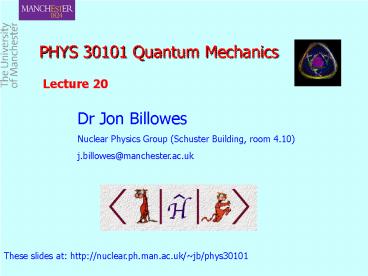PHYS 30101 Quantum Mechanics PowerPoint PPT Presentation
Title: PHYS 30101 Quantum Mechanics
1
PHYS 30101 Quantum Mechanics
Lecture 20
Dr Jon Billowes Nuclear Physics Group (Schuster
Building, room 4.10) j.billowes_at_manchester.ac.uk
These slides at http//nuclear.ph.man.ac.uk/jb/p
hys30101
2
6. The hydrogen atom revisited - Reminder of
eigenfunctions, eigenvalues and quantum numbers
n, l, ml of hydrogen atom. 6.1 Spin-orbit
coupling and the fine structure. 6.2 Zeeman
effect for single electron atoms in (a) a
weak magnetic field (b) a strong
magnetic field 6.3 Spin in magnetic field QM
and classical descriptions
3
RECAP 6. 1 Spin-orbit coupling and fine
structure
Classically an electron orbiting a nucleus of
charge Ze sees the nucleus in orbit around it
(a current loop) which produces a field at the
electron of
Putting I Ze/T where T is period of orbit
(obtained from the classical angular momentum
expression Lme?r2 ) we get
Electron magnetic moment is in direction of its
intrinsic spin
Thus interaction energy and corresponding
Hamiltonian can be written
(relativistic effect of Thomas precession)
4
The shift in energy of a state
is the eigenvalue of the spin-orbit Hamiltonian
j3/2 (4 states)
l1, s1/2
Ah2/2
ml1, 0, -1 ms1/2, -1/2 (6 states)
-Ah2
j1/2 (2 states)
The energy centroid is unchanged 4 X A/2 2 X A
5
6.2(a) Weak-field Zeeman effect
6.2(b) Strong-field Zeeman
For electron, B is much greater than the field it
sees due to its orbital motion. S and L
independently precess around B keeping ms and ml
constants of motion
L and S remain coupled to J. Classically J
precesses slowly around field B, keeping
Jz M a constant
B
B
S
S
ms
L
ml
L
6
Landé g-factor
7
The state
gJ -4/3
j3/2
l1, s1/2
Ah2/2
-Ah2
gJ -2/3
j1/2
(Spin-orbit splitting)
8
Zeeman structure for l 1, s 1/2 orbital
Strong field
Weak field
(-1,1/2) (1,-1/2)
PowerShow.com is a leading presentation sharing website. It has millions of presentations already uploaded and available with 1,000s more being uploaded by its users every day. Whatever your area of interest, here you’ll be able to find and view presentations you’ll love and possibly download. And, best of all, it is completely free and easy to use.
You might even have a presentation you’d like to share with others. If so, just upload it to PowerShow.com. We’ll convert it to an HTML5 slideshow that includes all the media types you’ve already added: audio, video, music, pictures, animations and transition effects. Then you can share it with your target audience as well as PowerShow.com’s millions of monthly visitors. And, again, it’s all free.
About the Developers
PowerShow.com is brought to you by CrystalGraphics, the award-winning developer and market-leading publisher of rich-media enhancement products for presentations. Our product offerings include millions of PowerPoint templates, diagrams, animated 3D characters and more.

